trench warfare
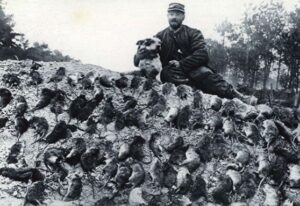
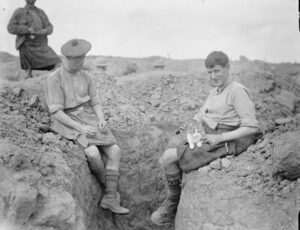 Trench warfare is a type of land warfare using occupied lines largely comprising military trenches, in which troops are well-protected from the enemy’s small arms fire and are substantially sheltered from artillery. That doesn’t protect them from many other weapons, like tanks, bomber planes, and some things that seem far more benign…rats and disease, not that these things aren’t dangerous. In fact, during World War I, these seemingly benign pests were becoming a deadly problem. Trench foot was one of the biggest disease problems, due to the wet and dirty conditions the men basically lived in.
Trench warfare is a type of land warfare using occupied lines largely comprising military trenches, in which troops are well-protected from the enemy’s small arms fire and are substantially sheltered from artillery. That doesn’t protect them from many other weapons, like tanks, bomber planes, and some things that seem far more benign…rats and disease, not that these things aren’t dangerous. In fact, during World War I, these seemingly benign pests were becoming a deadly problem. Trench foot was one of the biggest disease problems, due to the wet and dirty conditions the men basically lived in.
The rats…well, they were a bigger problem. The fact that the men “lived” in the trenches meant things like human waste, food scraps, and dead bodies drew the rats, and rats spread disease like typhus and the plague, 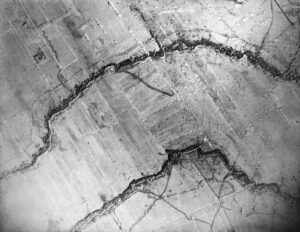 which made the problem of disease more deadly. Since trash disposal wasn’t easy in the trenches, the men often threw empty food tins out of the trenches at night. Then, the rats could be heard turning the tins over and licking the last tidbits out of them. For me the whole scene would be enough to make me want to run screaming from the scene, but that could get a soldier killed. Something had to be done…and done quickly. Due to the plentiful amount of food, some of these rats grew quite large in size. One story tells of a soldier who spotted one the size of a cat.
which made the problem of disease more deadly. Since trash disposal wasn’t easy in the trenches, the men often threw empty food tins out of the trenches at night. Then, the rats could be heard turning the tins over and licking the last tidbits out of them. For me the whole scene would be enough to make me want to run screaming from the scene, but that could get a soldier killed. Something had to be done…and done quickly. Due to the plentiful amount of food, some of these rats grew quite large in size. One story tells of a soldier who spotted one the size of a cat.
Something had to be done, so French troops tried to control the rat problem by bringing terrier dogs into the trenches with them. The plan was to let the dogs catch and kill rats, and it quickly became an interesting way to pass the time during daylight hours. Because of the dangers presented by the rats, the military actually offered soldiers a reward for killing the rats as incentive to decrease their numbers. It was a great idea, but not really practical, because rats are notoriously great escape artists…at least from humans. Nevertheless, apparently the troops got so into the 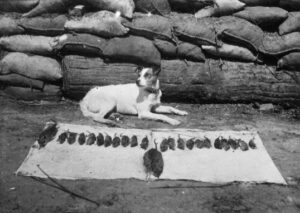
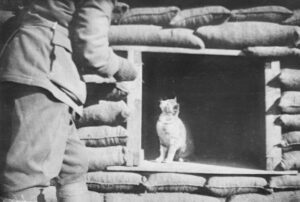 game, with one army corps managed to catch 8,000 in a single night. Other soldiers adopted cats instead of dogs, and it’s believed around 500,000 cats helped out in the trenches over the course of World War I. Many of the cats, and some of the dogs, ended up serving as mascots for troops on the front lines as well as hunters. I guess the plan worked, but maybe the animals should have been given a medal too.
game, with one army corps managed to catch 8,000 in a single night. Other soldiers adopted cats instead of dogs, and it’s believed around 500,000 cats helped out in the trenches over the course of World War I. Many of the cats, and some of the dogs, ended up serving as mascots for troops on the front lines as well as hunters. I guess the plan worked, but maybe the animals should have been given a medal too.
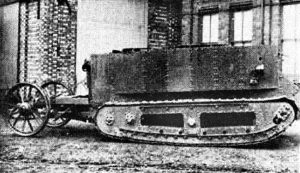 When I think of a tank, my thoughts go to an almost indestructible war machine, and I’m sure many people would agree with me. The tank was first introduced on September 6, 1915 in response to the trench warfare era of World War I. A British army colonel named Ernest Swinton and secretary of the Committee for Imperial Defense, William Hankey, championed the idea of an armored vehicle with “conveyor-belt-like tracks” over its wheels that could break through enemy lines and traverse difficult territory. It was a great idea, but the prototype tank nicknamed Little Willie manufactured in England was far from an overnight success. The tank was heavy, weighing in at 14 tons, but the big problem was that it got stuck in trenches and crawled over rough terrain at only two miles per hour. A tank isn’t much good if it has to be rescued, instead of rescuing the soldiers. It was also slow, and it became overheated and couldn’t cross the trenches. A second prototype, known as “Big Willie,” was produced. By 1916, this armored vehicle was deemed ready for battle and made its debut at the First Battle of the Somme near Courcelette, France, on September 15 of that year. Known as the Mark I, this first batch of tanks was hot, noisy and unwieldy and suffered mechanical malfunctions on the battlefield. Still, people began to realize the tank’s potential. Further design improvements were made and at the Battle of Cambrai in November 1917, 400 Mark IV’s proved much more successful than the Mark I, capturing 8,000 enemy troops and 100 guns.
When I think of a tank, my thoughts go to an almost indestructible war machine, and I’m sure many people would agree with me. The tank was first introduced on September 6, 1915 in response to the trench warfare era of World War I. A British army colonel named Ernest Swinton and secretary of the Committee for Imperial Defense, William Hankey, championed the idea of an armored vehicle with “conveyor-belt-like tracks” over its wheels that could break through enemy lines and traverse difficult territory. It was a great idea, but the prototype tank nicknamed Little Willie manufactured in England was far from an overnight success. The tank was heavy, weighing in at 14 tons, but the big problem was that it got stuck in trenches and crawled over rough terrain at only two miles per hour. A tank isn’t much good if it has to be rescued, instead of rescuing the soldiers. It was also slow, and it became overheated and couldn’t cross the trenches. A second prototype, known as “Big Willie,” was produced. By 1916, this armored vehicle was deemed ready for battle and made its debut at the First Battle of the Somme near Courcelette, France, on September 15 of that year. Known as the Mark I, this first batch of tanks was hot, noisy and unwieldy and suffered mechanical malfunctions on the battlefield. Still, people began to realize the tank’s potential. Further design improvements were made and at the Battle of Cambrai in November 1917, 400 Mark IV’s proved much more successful than the Mark I, capturing 8,000 enemy troops and 100 guns.
As with any new invention, the tank had a few “bugs” to be worked out. Still, I doubt if that did much to assuage the fears of the men in the tanks when they got stuck in the trenches. Tanks are supposed to be able to withstand gun shots and shrapnel, but would the tank be able to do so. After all, tanks weren’t supposed to get stuck either, so just how trustworthy was the armor plating. A tank that gets stuck is really just a “sitting duck.” Nevertheless, improvements were made to the original prototype and eventually tanks completely transformed military battlefields.
Trench warfare of World War I truly was brutal, almost more for the men in the trenches than anyone else.  Finally, the men appealed to British navy minister Winston Churchill, who believed in the concept of a “land boat” and organized a Landships Committee to begin developing a prototype. To keep the project secret from enemies, production workers were reportedly told the vehicles they were building would be used to carry water on the battlefield…alternate theories suggest the shells of the new vehicles resembled water tanks. Either way, the new vehicles were shipped in crates labeled “tank” and the name stuck. Tanks rapidly became an important military weapon. During World War II, they played a prominent role across numerous battlefields. The tanks potential was finally an accepted fact.
Finally, the men appealed to British navy minister Winston Churchill, who believed in the concept of a “land boat” and organized a Landships Committee to begin developing a prototype. To keep the project secret from enemies, production workers were reportedly told the vehicles they were building would be used to carry water on the battlefield…alternate theories suggest the shells of the new vehicles resembled water tanks. Either way, the new vehicles were shipped in crates labeled “tank” and the name stuck. Tanks rapidly became an important military weapon. During World War II, they played a prominent role across numerous battlefields. The tanks potential was finally an accepted fact.
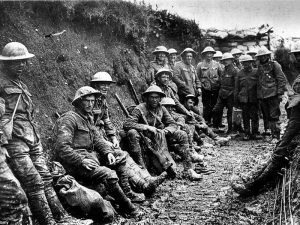 World War I brought a new kind of fighting…trench warfare. It actually started on September 15, 1914, when a battle dragged on far longer that anyone ever expected. The Battle of the Marne was expected to be over quickly, but the soldiers had other ideas. Allied troops halted the steady German push through Belgium and France that had proceeded over the first month of World War I, but neither side was willing to give up. Allied and German forces begin digging the first trenches on the Western Front. They were in this for the long haul. It was the beginning of trench warfare…a tactic that went on until 1918.
World War I brought a new kind of fighting…trench warfare. It actually started on September 15, 1914, when a battle dragged on far longer that anyone ever expected. The Battle of the Marne was expected to be over quickly, but the soldiers had other ideas. Allied troops halted the steady German push through Belgium and France that had proceeded over the first month of World War I, but neither side was willing to give up. Allied and German forces begin digging the first trenches on the Western Front. They were in this for the long haul. It was the beginning of trench warfare…a tactic that went on until 1918.
Trench warfare was a good tactic to use for the most part, because it provided some protection from the enemy forces on the ground. The air war during World War I was much different that the air war of World War II. There were no heavy bombers, and while  there were fighter planes, most of the war was fought on the ground…in the trenches. Soldier had some place to hide from the bullets that were flying by them at lightning speed. The men often used periscopes to safely see over the sides of the trenches. There is no completely safe way to fight hand to hand combat, but the trenches were often the best protection available. Still, while the trenches did provide a measure of protection, they had their dangers too. First, the trenches had to be dug, and the digging might easily be done with the enemy coming up on you fast, or worse yet, already there. The trenches were dug by the men, in ground that was often hard and rocky, but the job had to be done, and then the battle still had to be fought, no matter how weary the soldiers were…no matter how much they needed sleep, in a warm bed.
there were fighter planes, most of the war was fought on the ground…in the trenches. Soldier had some place to hide from the bullets that were flying by them at lightning speed. The men often used periscopes to safely see over the sides of the trenches. There is no completely safe way to fight hand to hand combat, but the trenches were often the best protection available. Still, while the trenches did provide a measure of protection, they had their dangers too. First, the trenches had to be dug, and the digging might easily be done with the enemy coming up on you fast, or worse yet, already there. The trenches were dug by the men, in ground that was often hard and rocky, but the job had to be done, and then the battle still had to be fought, no matter how weary the soldiers were…no matter how much they needed sleep, in a warm bed.
Sometimes, the the worst danger would become a reality, and it often had nothing to do with the enemy. 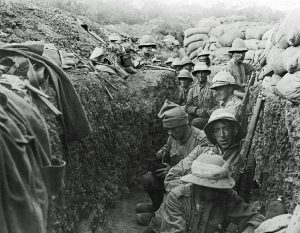 Sometimes, there were cave-ins of the trenches. If the soldiers caught in the cave-in were lucky, their fellow soldiers saw the cave-in, and quickly came to their fellow soldiers’ rescue. Sometimes, they could dig them out in time to save their lives. Unfortunately, all too often, they were too late. Worse yet, was the possibility that the battle was still raging, and while the soldiers knew of the peril their fellow soldiers were in, there was nothing they could do for them at that time, and when they could get too them, it was too late. Sometimes, no one was around to see the cave-in, and the bodies would not be found for months, or years, and sometimes never. Sometimes, these men would forever be listed as missing and presumed dead. And that was the worst fate of all.
Sometimes, there were cave-ins of the trenches. If the soldiers caught in the cave-in were lucky, their fellow soldiers saw the cave-in, and quickly came to their fellow soldiers’ rescue. Sometimes, they could dig them out in time to save their lives. Unfortunately, all too often, they were too late. Worse yet, was the possibility that the battle was still raging, and while the soldiers knew of the peril their fellow soldiers were in, there was nothing they could do for them at that time, and when they could get too them, it was too late. Sometimes, no one was around to see the cave-in, and the bodies would not be found for months, or years, and sometimes never. Sometimes, these men would forever be listed as missing and presumed dead. And that was the worst fate of all.

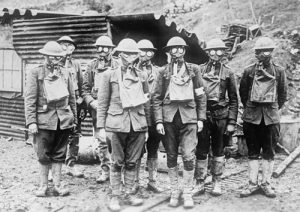 As nursing goes, I suppose you could say that World War I changed everything. War is an ugly business, and wounded men (and women these days) are just a part of the unavoidable side effects of it. As the upheaval of World War I changed the world, so the horrors of it, changed nursing.
As nursing goes, I suppose you could say that World War I changed everything. War is an ugly business, and wounded men (and women these days) are just a part of the unavoidable side effects of it. As the upheaval of World War I changed the world, so the horrors of it, changed nursing.
From 1914 to 1918, what was dubbed “the war to end all wars” in the innocence of the times, anyway…led to the mobilization of more than 70 million military personnel, including 60 million Europeans, making it one of the largest wars in history. As we know, it was hardly the war to end all wars, but it did change many of the things we had come to expect war to be. World War I was one of the deadliest conflicts in history. The death toll is staggering…estimated nine million combatants and seven million civilian deaths, as a direct result of the war. To add to that total, came the resulting genocides, as well as the 1918 influenza pandemic, which caused another 50 to 100 million deaths worldwide.
Now, just imagine being a nurse in those days. Of course, medical tents and hospitals were close to the perimeter of the fighting, to care for hurt soldiers quickly. This assured that the World War I nurses were witness to the conflict firsthand. I seriously doubt if any of them walked away from the war with less PTSD than the soldiers did. Many of them wrote about their involvement in diaries and letters that, similar to photographs from this time, offer insight into how they were personally impacted. The journals also include details about fighting, disease, and the hope that nurses and soldiers alike found in their darkest moments…if there could be any hope to be found.
It was in World War I that Germany introduced gas as a new form of aggression in 1915. It was in many ways the latest form of terrorism. To say that it was a different level of engagement seems an understatement. Gas devices became commonplace. They were worn anytime an air raid siren sounded, and some people wore them much of the time, as a precaution. The soldiers didn’t go anywhere without their gas mask. It was their life-line. Still, they were among the most feared elements of World War I.
“Sister Edith Appleton was a British nurse who served in France during World War I. She wrote about the soldiers stricken by gas and the adverse physical impacts they endured. The minimal immediate effects are tearing of the eyes, but subsequently, it causes build-up of fluid in the lungs, known as pulmonary edema, leading to death. It is estimated that as many as 85% of the 91,000 gas deaths in WWI were a result of phosgene or the related agent, diphosgene (trichloromethane chloroformate).”
Margaret Trevenen Arnold, a volunteer British Red Cross nurse in France in 1915 kept a diary of her time at Le Tréport and described “groans, and moans, and shouts, and half-dazed mutterings, and men with trephined heads suddenly sitting bolt upright… It was awful, and I really know now what [conflict] means.” These serious head injuries would most likely cause permanent brain damage for these men…if they survived at all.
Some hospital tents were eerily quiet, because the men in them were too sick to make a sound. Bandages were changed as often as every two hours, in an effort to ward off infection, and tourniquets to stop the bleeding until the soldier could be sent to surgery. Most of these field “hospitals” faced the same serious conditions…a lack of clean water and sterile surroundings. The nurses had to make due with what they had…and that often wasn’t much. Sometimes the lack of medicine became a major issue, especially when it came to anesthesia. Sometimes, the soldier had to simply force himself to remain calm, and steel himself to the inevitable pain of the surgery. These men had to place their faith in the doctors and nurses who cared for them, and they had not had time to even prepare for the need for surgery…let alone without anesthesia.
“Violet Gosset served on the Western Front from 1915 to 1919. While working at a hospital in Boulogne, France, Gosset kept notes about her experiences. She described a lack of supplies, overcrowded conditions, and scrapes that often resulted from a lack of adequate protection.”
“Helen Dare Boylston, an American nurse who served in France with the Harvard Unit medical team, had patients that spanned a wide range of age demographics. Some of the soldiers were just teenagers (“boys”), while others were in their 20s. However, Boylston recalled at least one soldier in his 60s (she called him “Dad”). Boylston saw the number of men in her care rise significantly in March 1918. At this time, she was sent…with two other nurses…to care for 500 soldiers. Boylston and her fellow nurses, including one named Ruth, quickly adapted to their conditions.”
Trench warfare was a shock to most of the soldiers. Still, most soldiers remained in good spirits. A part of nursing that might be considered a little different in the field hospitals is that the nurses are “in charge of” morale to a great degree. whether the men had Trench Foot, were sick, or wounded, they needed to have someone to lift their spirits. Who would have ever thought of nurses as morale boosters, but it was so.
Flu was widespread during World War I, even before the pandemic of 1918. After the pandemic began, things became critical. Now, nurses had to contend with treatment and prevention, in addition to other issues. One problem is that soldiers who ended up in medical tents and hospitals were often covered in mud, and flies frequently buzzed around them. Keeping germs at bay was next to impossible.
“Nurse Helen Dare Boylston was a keen observer of how soldiers reacted when they returned from the front, especially when they interacted with female nurses. She commented on the “fascinating game” of casual 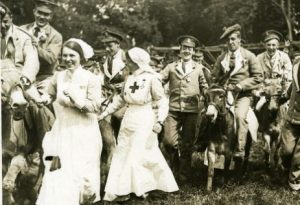
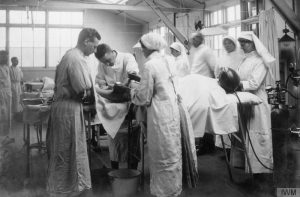 romance that commonly played out in the midst of conflict-related stress.” This was probably one of the most unusual phenomena, because nurses are told not to get emotionally involved, and yet here it was exactly what was needed. Nursing has changed over the years, but never has it been so evident as in World War I. It was as if nurses were making it up as they went along…and maybe they were.
romance that commonly played out in the midst of conflict-related stress.” This was probably one of the most unusual phenomena, because nurses are told not to get emotionally involved, and yet here it was exactly what was needed. Nursing has changed over the years, but never has it been so evident as in World War I. It was as if nurses were making it up as they went along…and maybe they were.
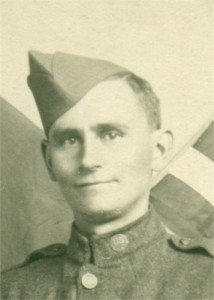 Many members of my family have fought in the many wars that have taken place in this world’s history…most of them I probably know nothing about. Wars, while usually necessary in order keep our nation secure; take a heavy toll on its youth. Of course, in years gone by, women were not placed in combat positions. That is no longer the case. Now women are among those war dead, just like men are.
Many members of my family have fought in the many wars that have taken place in this world’s history…most of them I probably know nothing about. Wars, while usually necessary in order keep our nation secure; take a heavy toll on its youth. Of course, in years gone by, women were not placed in combat positions. That is no longer the case. Now women are among those war dead, just like men are.
The weapons of warfare have become more and more deadly over the years, but I can’t say that there were more war dead because of that. War dead numbers seem to fluctuate with the war, and with the willingness to die, on the part of both sides. Sometimes however, something is invented, and then improved to save lives. Such was the case with the tank. On September 6, 1915, the tank, nicknamed Little Willie rolled off of the assembly line in England. That first tank was less than well received. It was slow…maxing out at 2 miles per hour. It weighed 14 tons, and kept getting stuck in the trenches. Nevertheless, it was important, since wars had moved into that type of fighting. Trench warfare often made soldiers sitting ducks…both the ones in the trenches, and the ones coming up on the trenches. The plan was to make a vehicle that could go cross country, and into the trenches with relative safety.
I’m sure the designers were very disappointed, but they didn’t give up. They went to work to improve this valuable piece of military equipment. The next model…Big Willie debuted a year later, and while it still needed improving, people could now see how important the vehicle would become in response to the trench warfare of World War I. The tank was in existence when my grandfather was drafted into World War I, but I don’t know if he ever had the opportunity to see one or ride in one. I can’t say if the tank changed the way that World War I was going, but it has definitely made a difference in the wars since that time.
The tank has come a long way since those days…including the name. It was never in the plan to call this piece of equipment a tank. They had planned to make a landboat, and organized a Landships Committee to begin development. It was vital that they keep the vehicle a secret from enemies, so workers were apparently told that they were building a machine to carry water on the battlefield. Some say that the tank resembled water tanks. Whatever the case may be, the new vehicles were shipped in crates labeled “tank” and the name stuck.

